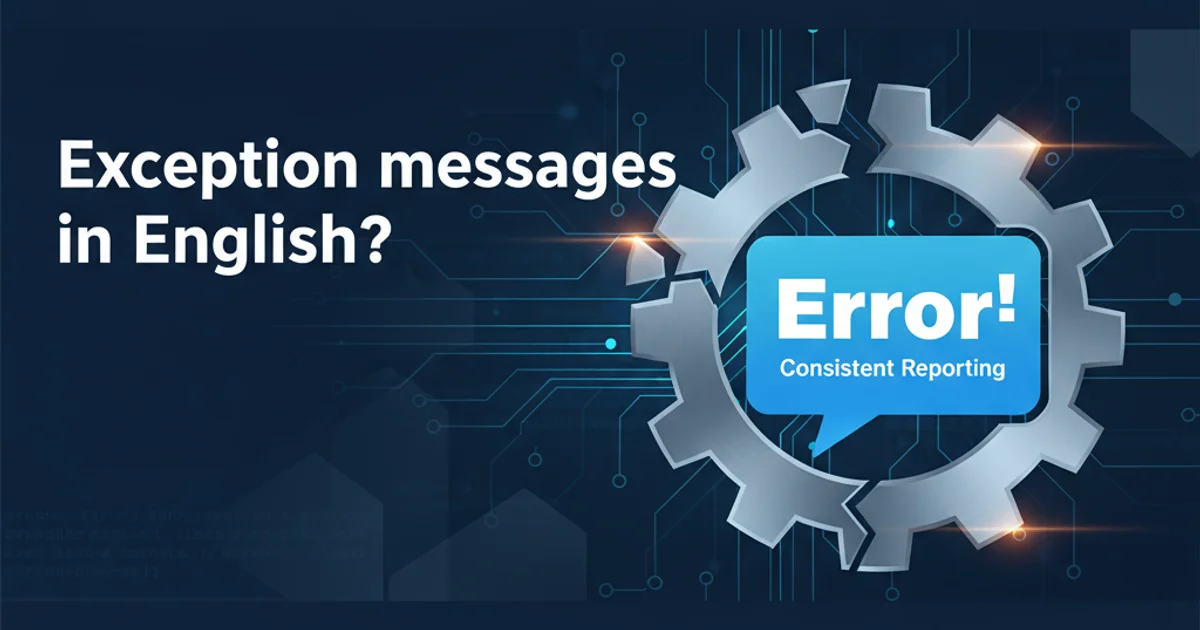Exception messages in English?
Categories:
Ensuring English Exception Messages in .NET Applications

Learn how to configure your .NET applications to consistently display exception messages in English, regardless of the user's operating system language settings.
When developing global applications, it's common to encounter situations where exception messages are localized based on the operating system's current UI culture. While localization is generally beneficial, for logging, debugging, and consistent error handling across different environments, it's often preferable to have exception messages consistently in English. This article will guide you through the methods to achieve this in your C# .NET applications.
Understanding Culture and Exception Localization
In .NET, the System.Globalization.CultureInfo class manages culture-specific information, including language, country/region, calendars, and number/date formats. Exception messages from the .NET Framework itself (e.g., ArgumentNullException, FileNotFoundException) are often localized based on the Thread.CurrentThread.CurrentUICulture property. If this property is set to a culture like 'de-DE' (German), framework exception messages will appear in German.
This behavior can lead to inconsistencies in logs, making it harder for support teams or automated monitoring systems to parse and react to errors, especially when an application is deployed globally or used by developers from different linguistic backgrounds. Our goal is to override this default behavior for exception messages.
flowchart TD
A[Application Starts] --> B{Thread.CurrentThread.CurrentUICulture?}
B -- OS Default --> C[Localized Exception Messages]
B -- Explicitly Set --> D[English Exception Messages]
C --> E[Inconsistent Logs]
D --> F[Consistent Logs]
E --> G[Debugging Challenges]
F --> H[Easier Debugging]Flowchart illustrating the impact of CurrentUICulture on exception message localization.
Method 1: Setting CurrentUICulture for the Application
The most straightforward way to ensure English exception messages is to explicitly set the CurrentUICulture for your application's main thread to an English culture, such as en-US or en-GB. This should be done early in your application's lifecycle, typically in the Main method for console/desktop apps or Program.cs for web applications.
using System;
using System.Globalization;
using System.Threading;
public class Program
{
public static void Main(string[] args)
{
// Set the UI culture to English (United States)
CultureInfo englishCulture = new CultureInfo("en-US");
Thread.CurrentThread.CurrentUICulture = englishCulture;
Console.WriteLine($"Current UI Culture: {Thread.CurrentThread.CurrentUICulture.Name}");
try
{
// This will throw an ArgumentNullException
string myString = null;
Console.WriteLine(myString.Length);
}
catch (Exception ex)
{
Console.WriteLine($"Exception Type: {ex.GetType().Name}");
Console.WriteLine($"Exception Message: {ex.Message}");
}
// Example of a localized message if culture was different
// CultureInfo germanCulture = new CultureInfo("de-DE");
// Thread.CurrentThread.CurrentUICulture = germanCulture;
// try { string s = null; Console.WriteLine(s.Length); } catch (Exception ex) { Console.WriteLine(ex.Message); }
}
}
Setting CurrentUICulture to 'en-US' to ensure English exception messages.
CurrentUICulture to en-US is common, you can also use en-GB or simply en if you prefer. The key is to pick an invariant English culture.Method 2: Using the Invariant Culture for Specific Operations
Sometimes, you might not want to change the CurrentUICulture for the entire application, as it affects other UI elements, date/time formatting, and number formatting. In such cases, you can temporarily set the culture or use the CultureInfo.InvariantCulture for specific operations where you need consistent, non-localized behavior. However, for exception messages, the CurrentUICulture of the thread where the exception is thrown is what primarily dictates the language of framework-generated messages.
If you are dealing with custom exception messages or logging, you can explicitly format them using CultureInfo.InvariantCulture or ensure your custom messages are always in English. For framework exceptions, setting CurrentUICulture as shown in Method 1 is the most effective approach.
using System;
using System.Globalization;
using System.Threading;
public class Program
{
public static void Main(string[] args)
{
// Preserve original UI culture
CultureInfo originalUICulture = Thread.CurrentThread.CurrentUICulture;
Console.WriteLine($"Original UI Culture: {originalUICulture.Name}");
try
{
// Temporarily set UI culture to English for a block of code
Thread.CurrentThread.CurrentUICulture = new CultureInfo("en-US");
Console.WriteLine($"Temporary UI Culture: {Thread.CurrentThread.CurrentUICulture.Name}");
string myString = null;
Console.WriteLine(myString.Length);
}
catch (Exception ex)
{
Console.WriteLine($"Exception Message (English): {ex.Message}");
}
finally
{
// Restore original UI culture
Thread.CurrentThread.CurrentUICulture = originalUICulture;
Console.WriteLine($"Restored UI Culture: {Thread.CurrentThread.CurrentUICulture.Name}");
}
// Example of a custom exception message that is always English
try
{
throw new InvalidOperationException("Custom operation failed due to an invalid state.");
}
catch (Exception ex)
{
Console.WriteLine($"Custom Exception Message: {ex.Message}");
}
}
}
Temporarily setting CurrentUICulture and handling custom English messages.
Configuration for ASP.NET Core Applications
For ASP.NET Core applications, you typically configure culture settings in the Startup.cs or Program.cs file. You can set the default request culture to English, which will influence the CurrentUICulture for incoming requests.
// In Program.cs (for .NET 6+ Minimal APIs) or Startup.cs (for older versions)
using System.Globalization;
using Microsoft.AspNetCore.Builder;
using Microsoft.Extensions.DependencyInjection;
var builder = WebApplication.CreateBuilder(args);
// Configure services
builder.Services.AddLocalization();
builder.Services.Configure<RequestLocalizationOptions>(options =>
{
var supportedCultures = new[] { new CultureInfo("en-US") };
options.DefaultRequestCulture = new Microsoft.AspNetCore.Localization.RequestCulture("en-US");
options.SupportedCultures = supportedCultures;
options.SupportedUICultures = supportedCultures;
});
var app = builder.Build();
// Configure the HTTP request pipeline.
app.UseRequestLocalization();
app.MapGet("/throw", () =>
{
// This exception message will be in English due to the configured UI culture
string data = null;
return data.Length.ToString();
});
app.Run();
Configuring request localization in ASP.NET Core to default to 'en-US'.
CurrentUICulture globally or for all requests will affect all localized resources, not just exception messages. If your application needs to display UI elements in different languages, you'll need a more granular approach, potentially involving try-catch blocks with explicit culture settings around code that might throw framework exceptions, or ensuring your logging infrastructure normalizes messages.By consistently applying one of these methods, you can ensure that your .NET application's exception messages remain in English, simplifying debugging, logging, and error analysis across diverse deployment environments.